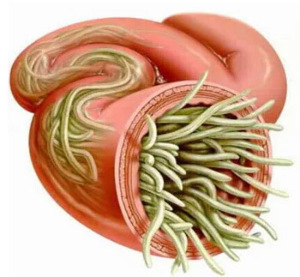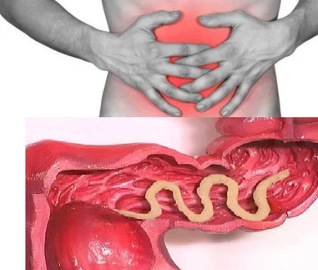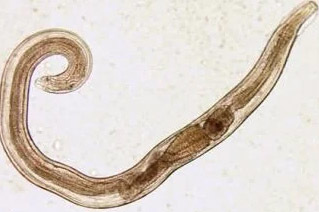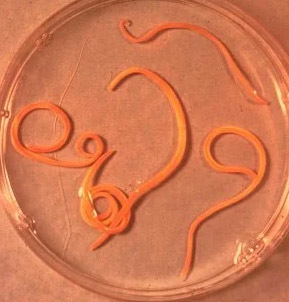Up to today the science knows about 280 species of worms, which can grow and live in a human body, the disease in the various organs and tissues. The frequency of infection by worms of a person depends on the climate and socio-economic conditions of specific territories (in the underdeveloped countries, in particular those that are located in tropical and subtropical regions of the area, the level of parasitic infections is significantly higher in developed countries).
Ways to infect the human helminths:
- Bioelements (infection from animals).
- Contagious helminthiasis (diseases from person to person).
- Geohelminths (diseases caused by parasites, the conductor of one of the cycles of life on earth).

The factors that influence the manifestations of the helminth
The method of penetration of the parasite in the body:
- The degree of adaptation of the elminto to the human body;
- Population density (number) of parasites specimens;
- Habitat worm (tissue parasites live in the thickness of the soft tissues, and translucent live in the lumina of hollow organs). Some of the helminths at various stages have, and translucent, and the fabric of the form. Larval development and stage of worms usually cause the most pronounced pathological changes.
In the absence of reinfection, the number of adult parasites in the human body is not increasing. This characteristic differs greatly worms infestation by diseases caused by bacteria, viruses, fungi and protozoa organisms.
Worms in humans: symptoms
The bot is a disease that is characterized by the 2 phase of the current (acute, from two weeks to two months) and chronic (from a few months to several years).
The symptoms of the acute phase of helminthiasis
The first signs of the disease may manifest itself at different times (usually 2-3 weeks, when ascariasis 2-3 days, and when filariose the incubation period can last 6-18 months).
In the acute phase installed infestations, the symptom is characteristic of an allergic reaction (occurs in the production of antibodies to the antigens of migration are the larvae of parasites). Often infested by the worms people on the skin appear rashes itchy, prone to retidiviruuschem in the valley, increased regional lymph nodes, perhaps the appearance of generalized or local edema, muscle and joint aches. Also the migration of the are the larvae of the parasite can cause chest pain, coughing, attacks of suffocation, disorders of the chair, nausea and vomiting.
At the same time, the acute phase helminthiasis may be accompanied by a more severe impairment (a severe form of pneumonia, viral hepatitis, allergic myocarditis, hepatosplenomegaly (enlarged liver and spleen).
In the blood increases the number of eosinophils (eosinophilia), and disturbed the normal proportions between the protein fractions (dysproteinemia).

Signs of chronic helminthiasis
The symptoms of the chronic phase depends on the type of the body "inhabited" by the parasites, and also play an important role they play and their size and quantity.
So, when the parasitism in the intestine individuals the disease can be asymptomatic (with the exception of the cases of infection, very large parasites). Typical signs of the chronic phase intestinal helminths are dyspepsia. In children to a greater extent is expressed asthenoneurotic syndrome of the pain. When a massive invasion Ascaris can be the development of intestinal obstruction, mechanical jaundice and pancreatitis.
Consuming all that is necessary for the livelihood of the substance by the organism, the host, helminths are the cause of digestive disorders, malabsorption of vitamins, minerals, carbohydrates, proteins and fats. At the same time, the waste products of the worms inhibit the normal intestinal microflora and reduce the immune strength of the body.
In people who suffer from elmintiasimi, because of a compromised immune system and reinforcement of the process of cell division (effect is permanent damaged by parasites of the tissues) greatly increases the risk of onset of malignant tumors.
The types of worms, parasites in the human body
Pathogens helminths person are 2 types of worms: round (nematodes) and flat (band and flukes).
The nematodes
Pinworm
Parasites, which are the cause of enterobiasis is of small size (up to 10mm) thin cavitali worms, having gray-and-white coloring. The infection is food (through the mouth). The reason for this – your hands dirty. The eggs of the parasite can be in the ground, in wool of infected animals, piles of fruit and vegetables, etc. however, for the enterobiosi there are cases samsarajade (especially in children), arising from scratching itches areas, and the subsequent ingestion of eggs. The larva ossiuri develops in the course of two weeks in the digestive tract. Becoming an adult individual, a worm parasite in the lower regions of thin and upper regions of the colon.

Ascaris
Ascaris is a parasite fusiform, red-yellow, reaching adulthood at 40 cm (females) and 15-25 cm (males). Not having suction cups or other fixed lamps, Ascaris, is able to move autonomously towards food masses. The eggs, pending the female of the parasite, stand out together with the faeces.
The infection ascariasis happens in case of ingestion of mature eggs together with the water, or unwashed fruits and vegetables, which are particles of soil. After the penetration of eggs in the intestine of their out of the are the larvae mature. Then, by infiltrating the wall of the colon, which, in the blood reaches the heart, and from there enter into the lungs. Through the alveoli of the lungs the larva roundworms respiratory tract new enters the oral cavity. After the re-ingestion of the parasite reaches the small intestine, where it develops into an adult individual. Worm lives for 12 months, then it dies and stands out together with the faeces. In the intestine of a guest can live as one, and several hundred specimens.
Trichuris trichuris
Trichuris trichuris, the causative agent trichuriasis, is worm, white in color, parasitic, initial department of the large intestine and reaching size of 4-5 cm in the parasite Feeds on blood and mucosal tissues of the rectum.
The eggs lander module, pending the female on the walls of the intestine, open to the outside with the feces to the masses. Their development occurs in an environment (preferably into the soil). Eggs mature in their are the larvae of the parasite penetrate into the body in food, through dirty hands, with water, or unwashed fruits and vegetables.

Trichinella
The etiologic agent trichinosis – this is the small round worms, reaching 2-5 mm in length. The infection occurs when you consume bad fried meat (pork, bear meat, muscles). Penetrating in the intestine, the larva pest for 3-4 days, to mature on the condition of the Mature specimens. The duration of the life of a worm is 40 days, after which the parasite dies. Prosurvival intestinal wall, are the larvae penetrate into the blood circulation and circulation in all organs of the human body, settling in the muscles. In this case, it affects more often of breathing and facial muscles, and the flexor muscles of the limb.
In the early days after the invasion of the patients complain of stomach pain. Then, after about 2 weeks, the body temperature rises up to 39-40 on the skin appear rashes itchy, you develop muscle pain, swollen face. In this period, in the case of a massive infection, there is a substantial risk of death. After about a month starts the recovery. The parasite is encapsulated in the form of a spiral, after that for two years dies.
The hookworm and necator
These two parasites are similar to biological characteristics, but also for the recipient of the disease. With this regard, they have decided to unite under a common name (hookworm). Worms, reaching a length of 10-15 mm, parassitano 12-p. intestine. It should be noted that this is one of the most common, but, at the same time, quite rarely detectable parasites. The are the larvae of the worms penetrate the human body through the skin in case of contact with the infected soil. Next, enter in the blood stream, which, just like roundworms, they migrate into the lungs, and then, through the bronchi, together with otharkivajushche phlegm – in the digestive tract. The hookworm parasite in the intestine, which attaches to the intestinal wall. A parasite that feeds exclusively on blood, biting through and beat the mucosal blood vessels, which injects there anticoagulation component. For the day the adult, on average, able to absorb and 0.05-0.35 ml of blood. Then the symptom that is most characteristic of this helminthiasis is the iron deficiency anemia, but also the change of the ratio among the protein fractions (dysproteinemia).
Flat worms
A tapeworm
This is one of the larger helminths, reaching a length of 10-20 metres. The disease caused by the data parasite, called difilloʙotrioz. The development cycle of a worm starts with fresh water fish or crustaceans. In the human body, which is the definitive host for the lentetsa, the larva enters together with caviar or infected fish fillet. That reach the small intestine, the parasite attaches to the wall and in a matter of 20-25 days has progressed up to Mature specimens.
Liver Fluke
The parasite that causes opisthorchiasis and is a flat worm, reaching lengths of 7-20 mm. note that more than 50% of cases of infection of the liver Flukeom (also called cat plaice) represented for the inhabitants of Russia. The are the larvae of the parasite began to develop after the shot of the eggs in fresh water (from swallowing them snails). Subsequently, they penetrate into the body of the fish (carp, crucians, bream, roach). Human infection occurs when the consumption of food contaminated with the oil of fish meat, it is not passed enough of the heat treatment. The larva liver Flukee from the small intestine penetrate into the bile ducts and gall bladder, setting there with two suction cups.
Bovine and pork tapeworm
These virtually identical in their structure parasites reach a length of 5-6 meters. The infection beef tapeworm infection and teniasis occurs due to the consumption of beef or pork infested Finnish (one of the modules in the intermediate helminthiasis). Possible Finnish, presented in the form of bubbles, whitish, reaching the size of 0.5 cm, attach to the wall of the small intestine of man and for 3 months they turn into adults individual. Tape the parasite, consisting of more than 2000 segments, it is in constant growth. When this end-member, containing the eggs, detach and move only the colon to the anal hole, and then crawl out from the anus, or stand out in the external environment with the feces. The most characteristic symptoms of helminthiasis is the bad functioning of the digestive system.
Echinococcus
For this parasite, man is an intermediate host. Worm parasite in the human body in the form of Finnish. The final master of hooks – wolf, a dog or a cat. The infection occurs in food through the contact with the animals and with objects in the environment, seeding the eggs of the hooks. After contact with the intestine, they develop oncospheres (shestigrannye are larvae). From the intestine penetrate into the bloodstream and spread throughout the body.
Alveolar
This pest, which is considered to be a sort of echinococcus is the cause of one of the most dangerous helminth (of alveococcosis), and the gravity losses similar with the cirrhosis and liver cancer. The infection occurs during the penetration of oncospheres (eggs mature they are larvae) in the intestine. There is the embryo goes from eggs and infiltrates in the intestinal walls, penetrate the blood stream. Then, with the current of the blood, the parasite spreads in all tissues and organs of the body (often localized in the liver). It is there that you are the larvae starts the main development phase (formed multi-chamber bubble, labrocyte). Each cell contains the embryonic head, the parasite, which continues to develop gradually. Eurocity is a very aggressive formation, growth continues due to rising bubbles, but also with the ability to germinate in the liver, such as cancer metastasis.
Diagnosis of helminth
The diagnosis of parasitic infestations include the following activities:
- a careful anamnesis will help us to understand if the possible causes of infection;
- laboratory tests fecal, blood, content, 12p colon and rectal and perianal mucus, muscle tissue, lung phlegm, bile. During the course of analysis can be identified, the eggs, the members or the steps of the parasites. Together with higher blood levels of eosinophils is also a signal of the presence of helminthiasis.
- for the diagnosis of diseases caused by the larval stages of tissue or pest control, are carried out serological studies (ELISA, RAC, the reaction of agglutination indirect immunofluorescence analysis, etc).
- to identify the parasites that affect the liver tissue, is assigned to ULTRASOUND, CT scans, and endoscopic research.
The worms of a person: the treatment
In the acute phase of an infection, parasitic patient is assigned detoxification therapy and desensitizing. During severe illness (the trematode liver, trichinosis) to the medical indications are used glucocorticoids.
As drugs of specific therapy, in view of the nature of the pathogen are assigned special de-worming chemotherapy.
In parallel, the patient is recommended the intake of antihistamines and enterosorbents. The final stage of treatment involves the use of probiotics, normalizing the intestinal microflora.
Also assigned a special bland diet (the food must be easily digestible and contain few fats).
In the period anthelmintic therapy of the patient requires strict adherence to personal hygiene (to prevent re-infection). At the same time, in many helminthoses treatment must pass all of the family members, and persons with infection are in constant contact.






































